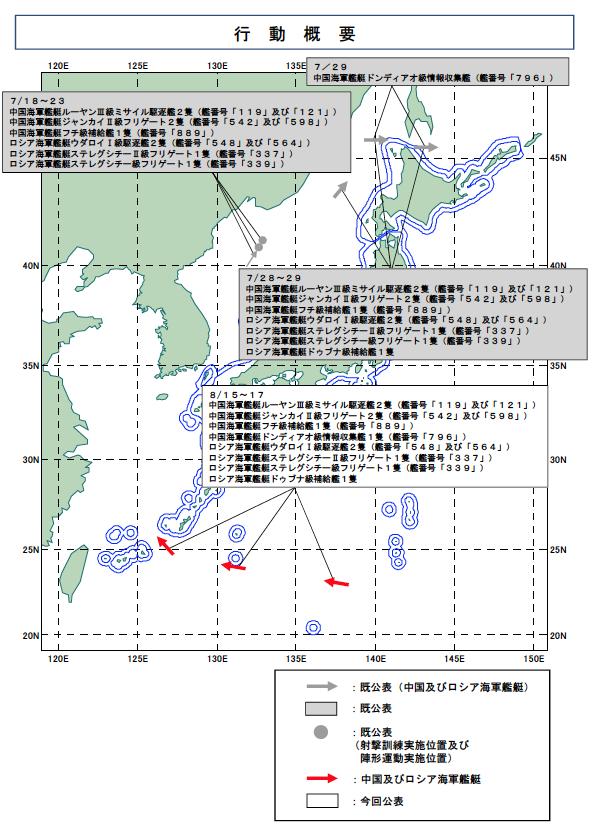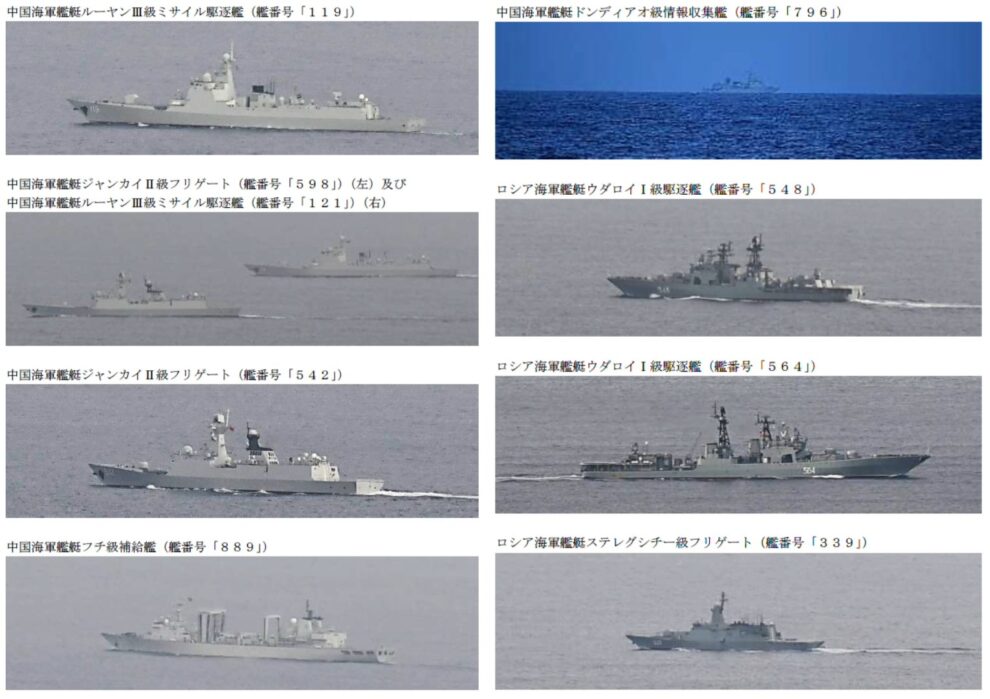The joint Russian Navy – People’s Liberation Navy (PLAN) flotilla that sailed near Alaska and the Aleutian Islands in early August is now operating in the East China Sea, according to a Thursday Japan Ministry of Defense release.
The flotilla has been sailing together since July 27, when it departed from Vladivostok, Russia. At that time it consisted of 10 ships: Russian Navy destroyers RFS Admiral Panteleyev (548) and RFS Admiral Tributs (564); corvettes RFS Gremyashchiy (337) and RFS Hero of the Russian Federation Aldar Tsydenzhapov (339); and fleet tanker Pechenga, while the PLAN ships are Chinese destroyers CNS Guiyang (119) and CNS Qiqihar (121); frigates CNS Zaozhuang (542) and CNS Rizhao (598); and fleet oiler CNS Taihu (889).
When the flotilla sailed near Alaska, it had 11 ships, according to a joint statement by Sens. Lisa Murkowski (R-Alaska) and Dan Sullivan (R-Alaska). However, no details were disclosed on the identity of the ships. The 11th ship, identified as Dongdiao class surveillance ship Kaiyangxing (796) by the Joint Staff Office of the Japanese Ministry of Defense, is still with the flotilla, according to the Thursday release.
The original 10 ships and Kaiyangxing transited La Perouse Strait to enter the Sea of Okhotsk between July 28-29, which makes it likely that Kaiyangxing was the 11th ship sighted when the flotilla sailed near Alaska, according to the JSO release.
The Japanese spotted the flotilla at 9 a.m. Tuesday, as it sailed westward in an area 280km northeast of Okinotorishima, a coral reef located in the Philippine Sea that is administered by Japan, according to the JSO release.

JMSDF Image
On Wednesday, the flotilla was sighted sailing west in an area 50km south of Oki Daito Island. It sailed northwest Thursday to transit the Miyako Strait between Miyako Island and Okinawa and then entered the East China Sea.
Japan Maritime Self Defense Force (JMSDF) destroyers JS Umigiri (DD-158) and JS Sawagiri (DD-157), minesweeper JS Yakushima (MSC-602) and JMSDF P-3C Orions Maritime Patrol Aircraft (MPA) of Fleet Air Wing 5 based at Naha Air Base, Okinawa, shadowed the flotilla, according to the JSO release.
The Russian-China Joint Patrol is the third one that the two countries have carried out. The patrols have been carried out on an annual basis.
On Monday, China Ministry of National Defense spokesperson Senior Col. Wu Qian pushed back against criticisms of the joint patrol during a press briefing.
“The cooperation between the Chinese and Russian militaries is completely different from the practices of some other countries that cling to the Cold War mentality, engage in camp confrontation and bully hegemony everywhere,” Wu said.
Naval vessels of Chinese and Russian militaries recently conducted joint maritime patrols in relevant waters of the western and northern Pacific Ocean based on the annual cooperation plan between the two militaries and abided by international law, he said. Patrols did not target any third party and had nothing to do with the current international and regional situation.
Wu also criticized Japan’s close-range surveillance, saying it was very dangerous, and could easily lead to causing misunderstanding, misjudgment and accidents at sea and in the air. He urged Japan to cease the practice.
“Unlike some other countries’ clinging to the Cold War mentality, engaging in camp confrontation and hegemony everywhere, the cooperation between the Chinese and Russian militaries is open and transparent, and aims to jointly defend international fairness and justice and maintain world and regional security and stability,” Wu said.
On Thursday, the PLAN’s 43rd Chinese Naval Escort Taskforce consisting of destroyer CNS Nanning (162), frigate CNS Sanya (574) and fleet oiler Weishanhu (887) arrived at the Port Klang Cruise Terminal, Port Klang, Malaysia, which lies along on the Malacca Strait, according to a Facebook post by the Royal Malaysian Navy (RMN) National Hydrographic Center.
The cruise terminal used to be the Glenn Cruise Terminal when it served as the headquarters for Glenn Defense Marine Asia, owned by Leonard “Fat Leonard” Francis. It was sold off following Francis’s arrest in 2013.
China’s 43rd Chinese Naval Escort Taskforce is an anti-piracy escort taskforce. The PLAN has been deploying its anti-piracy escort task forces to the Gulf of Aden since 2009.
The 43rd Chinese Naval Escort Taskforce had handed off its mission to the 44th Naval Escort Taskforce consisting of destroyer CNS Zibo (156), frigate CNS Jingzhou (532), and fleet oiler CNS Qiandaohu (886) on June 2
It has since conducted various port visits to African nations before carrying out its homeward-bound voyage.
Source : USNI










